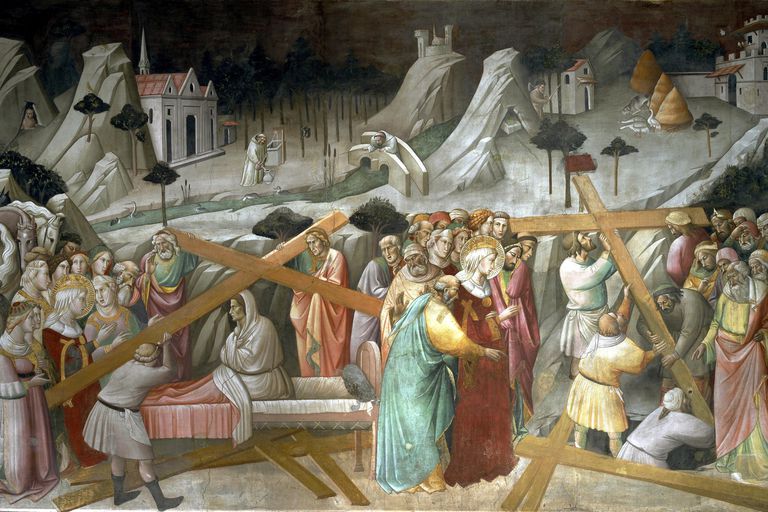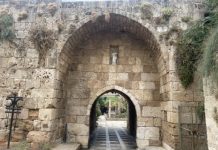
ذكرى ارتفاع الصليب المقدسة
“من أراد ان يتبعني فلينكر نفسه ويحمل صليبه ويتبعني
من رسالة بولس الرسول الأولى إلى أهل كورنثوس (من 18حتى25):”إنَّ كَلِمَةَ الصَّلِيبِ عِنْدَ الهَالِكِينَ حَمَاقَة، أَمَّا عِنْدَنَا نَحْنُ المُخَلَّصِينَ فَهِيَ قُوَّةُ الله؛ لأَنَّهُ مَكْتُوب: “سَأُبِيدُ حِكْمَةَ الحُكَمَاء، وأَرْذُلُ فَهْمَ الفُهَمَاء فَأَيْنَ الحَكِيم؟ وأَيْنَ عَالِمُ الشَّرِيعَة؟ وأَيْنَ البَاحِثُ في أُمُورِ هذَا الدَّهْر؟ أَمَا جَعَلَ اللهُ حِكْمَةَ هذَا العَالَمِ حَمَاقَة؟ فَبِمَا أَنَّ العَالَمَ بِحِكْمَتِهِ مَا عَرَفَ اللهَ بِحَسَبِ حِكْمَةِ الله، رَضِيَ اللهُ أَنْ يُخَلِّصَ بِحَمَاقَةِ البِشَارَةِ الَّذِينَ يُؤْمِنُون؛ لأَنَّ اليَهُودَ يَطْلُبُونَ الآيَات، واليُونَانِيِّينَ يَلْتَمِسُونَ الحِكْمَة. أَمَّا نَحْنُ فَنُنَادِي بِمَسِيحٍ مَصْلُوب، هُوَ عِثَارٌ لِليَهُودِ وحَمَاقَةٌ لِلأُمَم. وأَمَّا لِلمَدْعُوِّينَ أَنْفُسِهِم، مِنَ اليَهُودِ واليُونَانِيِّين، فَهُوَ مَسِيحٌ، قُوَّةُ اللهِ وَحِكْمَةُ الله؛ فَمَا يَبْدُو أَنَّهُ حَمَاقَةٌ مِنَ اللهِ هُوَ أَحْكَمُ مِنَ النَّاس، ومَا يَبْدُو أَنَّهُ ضُعْفٌ مِنَ اللهِ هُوَ أَقْوَى مِنَ النَّاس”.
The Exaltation Of The Holy Cross Feast
Paul’s First Letter to the Corinthians/01/17-25/:”17 For Christ sent me not to baptize, but to preach the Good News—not in wisdom of words, so that the cross of Christ wouldn’t be made void. 18 For the word of the cross is foolishness to those who are dying, but to us who are being saved it is the power of God. 19 For it is written,“I will destroy the wisdom of the wise. I will bring the discernment of the discerning to nothing.” 20 Where is the wise? Where is the scribe? Where is the lawyer of this world? Hasn’t God made foolish the wisdom of this world? 21 For seeing that in the wisdom of God, the world through its wisdom didn’t know God, it was God’s good pleasure through the foolishness of the preaching to save those who believe. 22 For Jews ask for signs, Greeks seek after wisdom, 23 but we preach Christ crucified: a stumbling block to Jews, and foolishness to Greeks, 24 but to those who are called, both Jews and Greeks, Christ is the power of God and the wisdom of God; 25 because the foolishness of God is wiser than men, and the weakness of God is stronger than men.
The Feast of the Exaltation of the Holy Cross
Scott P. Richert
The Feast of the Exaltation of the Holy Cross, celebrated every year on September 14, recalls three historical events: the finding of the True Cross by Saint Helena, the mother of the emperor Constantine; the dedication of churches built by Constantine on the site of the Holy Sepulchre and Mount Calvary; and the restoration of the True Cross to Jerusalem by the emperor Heraclius II. But in a deeper sense, the feast also celebrates the Holy Cross as the instrument of our salvation. This instrument of torture, designed to degrade the worst of criminals, became the life-giving tree that reversed Adam’s Original Sin when he ate from the Tree of the Knowledge of Good and Evil in the Garden of Eden.
Quick Facts
Date: September 14
Type of Feast: Feast
Readings: Numbers 21:4b-9; Psalm 78:1bc-2, 34-35, 36-87, 38; Philippians 2:6-11; John 3:13-17
Prayers: The Sign of the Cross
Other Names for the Feast: Triumph of the Cross, Elevation of the Cross, Roodmas, Holy Cross
History of the Feast of the Exaltation of the Holy Cross
After the death and resurrection of Christ, both the Jewish and Roman authorities in Jerusalem made efforts to obscure the Holy Sepulchre, Christ’s tomb in the garden near the site of His crucifixion. The earth had been mounded up over the site, and pagan temples had been built on top of it. The Cross on which Christ had died had been hidden (tradition said) by the Jewish authorities somewhere in the vicinity.
Saint Helena and the Finding of the True Cross
According to tradition, first mentioned by Saint Cyril of Jerusalem in 348, Saint Helena, nearing the end of her life, decided under divine inspiration to travel to Jerusalem in 326 to excavate the Holy Sepulchre and attempt to locate the True Cross. A Jew by the name of Judas, aware of the tradition concerning the hiding of the Cross, led those excavating the Holy Sepulchre to the spot in which it was hidden.
Three crosses were found on the spot. According to one tradition, the inscription Iesus Nazarenus Rex Iudaeorum (“Jesus of Nazareth, King of the Jews”) remained attached to the True Cross. According to a more common tradition, however, the inscription was missing, and Saint Helena and Saint Macarius, the bishop of Jerusalem, assuming that one was the True Cross and the other two belonged to the thieves crucified alongside Christ, devised an experiment to determine which was the True Cross.
In one version of the latter tradition, the three crosses were taken to a woman who was near death; when she touched the True Cross, she was healed. In another, the body of a dead man was brought to the place where the three crosses were found, and laid upon each cross. The True Cross restored the dead man to life.
The Dedication of the Churches on Mount Calvary and the Holy Sepulchre
In celebration of the discovery of the Holy Cross, Constantine ordered the construction of churches at the site of the Holy Sepulchre and on Mount Calvary. Those churches were dedicated on September 13 and 14, 335, and shortly thereafter the Feast of the Exaltation of the Holy Cross began to be celebrated on the latter date. The feast slowly spread from Jerusalem to other churches, until, by the year 720, the celebration was universal.
The Restoration of the True Cross to Jerusalem
In the early seventh century, the Persians conquered Jerusalem, and the Persian king Khosrau II captured the True Cross and took it back to Persia. After Khosrau’s defeat by Emperor Heraclius II, Khosrau’s own son had him assassinated in 628 and returned the True Cross to Heraclius. In 629, Heraclius, having initially taken the True Cross to Constantinople, decided to restore it to Jerusalem. Tradition says that he carried the Cross on his own back, but when he attempted to enter the church on Mount Calvary, a strange force stopped him. Patriarch Zacharias of Jerusalem, seeing the emperor struggling, advised him to take off his royal robes and crown and to dress in a penitential robe instead. As soon as Heraclius took Zacharias’ advice, he was able to carry the True Cross into the church.
For some centuries, a second feast, the Invention of the Cross, was celebrated on May 3 in the Roman and Gallican churches, following a tradition that marked that date as the day on which Saint Helena discovered the True Cross. In Jerusalem, however, the finding of the Cross was celebrated from the beginning on September 14.
Why Do We Celebrate the Feast of the Holy Cross?
It’s easy to understand that the Cross is special because Christ used it as the instrument of our salvation. But after His Resurrection, why would Christians continue to look to the Cross?
Christ Himself offered us the answer: “If any man will come after me, let him deny himself, and take up his cross daily, and follow me” (Luke 9:23). The point of taking up our own cross is not simply self-sacrifice; in doing so, we unite ourselves to the sacrifice of Christ on His Cross.
When we participate in the Mass, the Cross is there, too. The “unbloody sacrifice” offered on the altar is the re-presentation of Christ’s Sacrifice on the Cross. When we receive the Sacrament of Holy Communion, we do not simply unite ourselves to Christ; we nail ourselves to the Cross, dying with Christ so that we might rise with Him.
“For the Jews require signs, and the Greeks seek after wisdom: But we preach Christ crucified, unto the Jews indeed a stumbling block, and unto the Gentiles foolishness . . . ” (1 Corinthians 1:22-23). Today, more than ever, non-Christians see the Cross as foolishness. What kind of Savior triumphs through death?
For Christians, however, the Cross is the crossroads of history and the Tree of Life. Christianity without the Cross is meaningless: Only by uniting ourselves to Christ’s Sacrifice on the Cross can we enter into eternal life.
https://www.thoughtco.com/feast-exaltation-of-the-holy-cross-542472






















